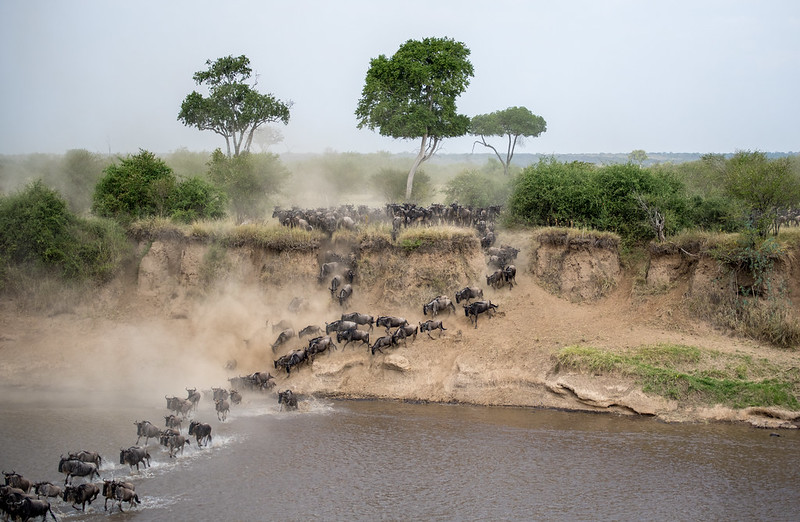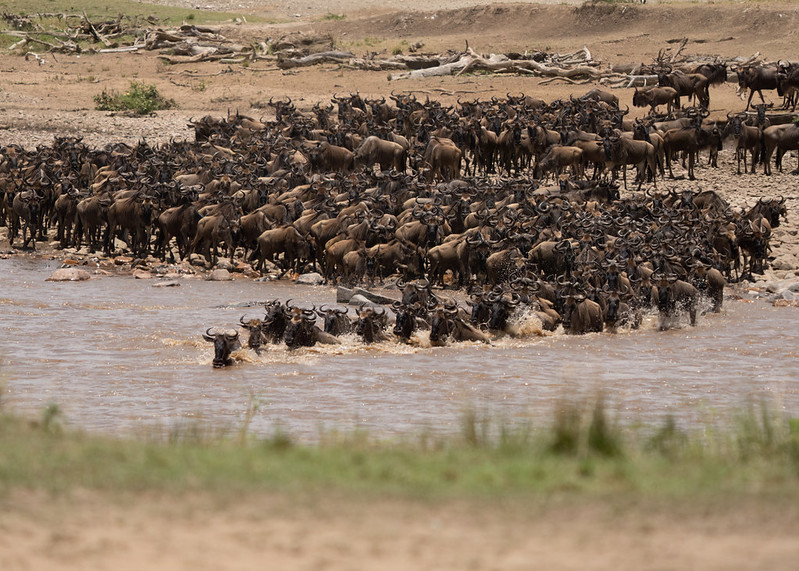The Wildebeests start arriving Kenya in June and by July- August, the entire plains of Mara have been occupied by the wildebeests, zebras and gazelles and its when mara crossing is in progress
Amboseli National Park In Kenya
Overview
Amboseli National Park, one of Kenya’s well-liked parks, offers vistas of Kilimanjaro, the tallest mountain in Africa. On the border between Kenya and Tanzania, in the general vicinity of Tanzania’s Mount Kilimanjaro, is the enchanted kingdom of elephants. Amboseli is primarily made up of acacia woodland, rocky thorny bush, muddy marshes, and lakes. It is well-known for its frequent sightings of enormous elephant herds. The 392 square kilometre park is a portion of the much larger 3,000 square kilometre Amboseli ecosystem.
The Maasai term for Amboseli, which translates to “salty dust,” is reflected in the contrast between the dry areas of the dried lake bed and the oasis of the marshes. The best place in the world to get up close and personal with free-roaming elephants is Amboseli National Park. Amboseli is home to the largest and most extensively researched population of elephants in the world, with a record of over 1600 elephants living inside its environment. As a result, the Park has become one of Kenya’s most popular locations to watch games.
In addition to these animals, the Amboseli National Park is home to Cape buffaloes, impalas, lions, cheetahs, spotted hyenas, Masai giraffes, Grant’s zebras, and wildebeest. Large and small bird species of various sizes can be found here. And before it was gazetted into a park, Amboseli was first designated as the Maasai Southern Reserve. One of the most fascinating African tribes to get to know is the Maasai, who can be encountered during a wildlife safari to this Kenyan location. Amboseli is Kenya’s second most popular tourist attraction despite its tiny size, only the renowned Masai Mara national reserve is more well-known.

Related Kenya Safaris
Attractions In This National Park
Animals in Amboseli National Park
Safari enthusiasts frequently travel to Amboseli National Park. The park is well recognized for housing the majority of elephants in Kenya, earning it the moniker “Home of Elephants.” Five main habitats make up the majority of the wildlife in Amboseli National Park: the dried-up lake bed, wetlands around Sulphur Springs, savannah vegetation cover, open plains, and woods. Giraffe, spotted hyena, zebra, buffalo, blue wildebeest, cheetah, elephant, Thomson’s gazelle, lion, cape buffalo, and Impala are among the animals that may be found in the park.
The diverse biodiversity of Amboseli makes for excellent game viewing, and the dry season, which lasts from June to October, is the optimum time to take a game drive and see animals. For the best photo chances, go to the park in the dry season when vast herds of animals are passing over the sand plains, stirring up a lot of dust. Additionally, during the dry season, animals congregate around the surviving waterholes, creating breathtaking views. The wildlife in the park can be seen in great detail from the observation hill and sinet delta.
Birds in Amboseli National Park
Amboseli is home to over 425 bird species, including common, rare, endemic, and migratory bird species that come to the park every year. Numerous bird species can be found in the Park thanks to its substantial forest cover; water birds, for instance, are typically spotted in areas that catch water, such wetlands. A variety of aquatic species, such as kingfishers, pelicans, herons, and egrets, among others, can be expected. The grasslands of the park are also home to countless bustards and starlings, to name a few.
Amboseli National Park is one of Kenya’s Important Birding Areas (IBA) due to its extraordinary avian richness. The “Lilac Breasted Roller,” Kenya’s national bird, is the park’s most prominent species. The Marabou stork, the secretary bird, the Madagascar pond, Fischer’s sparrow lark, Lesser kestrel, Grey-crowned crane, Rufous-napped lark, and Common Ostrich are among the other bird species. Fulvous Whistling Duck, Egyptian Goose, Pied Kingfisher, Steel-blue Whydah, African Pygmy-Goose, Red-billed Duck, Falcon, Helmeted Guinea bird, African Black Duck, Somali Bunting, Double-banded Courser, and others are among the additional species found in Amboseli.
Lakes
The western section of Amboseli National Park is home to a series of seasonal lakes that add to the park’s breathtaking splendour. The lakes, which are typically replenished during the rainy season, are located in the area of a former Pleistocene Lake’s drained basin. Lake Amboseli, Lake Kioko, Lake Simek, and Lake Conch are a few of these lakes.
These lakes’ borders include lush papyrus swamps that are havens for numerous aquatic bird species, making them popular destinations for bird-watching expeditions in Amboseli National Park. Lakes in Amboseli National Park are great for wildlife observation as well as bird watching because animals frequent the lakes for water.
The Observation Hill
Amboseli National Park’s observation hill is a well-known site that you shouldn’t miss while visiting Kenya. In the western part of Amboseli National Park, there is a pyramid-shaped hill that was once inhabited by the hunter-gatherers known as Ndorobo. Some of their remnants can still be seen today. On the other hand, it is believed that the observation hill was formed as a result of a Pleistocene activity that occurred during the formation of Mount Kilimanjaro
Only in Amboseli National Park are visitors on a game viewing safari in Kenya permitted to disembark from their safari vehicles and go for a stroll. Visitors can ascend the hill’s viewing point at its summit using a spiral staircase made of volcanic rocks. You can see Amboseli’s swamps, marshes, savannah grasslands, and a variety of animals from the hill’s vantage point.
The Maasai
One of the most real African civilizations to experience is the Maasai village that surrounds Amboseli National Park. Amboseli National Park’s borders are dominated by the fascinating Masai people, therefore visiting a Masai village is a must-do experience that provides a glimpse into authentic African culture.
In the Masai hamlet, you can observe Maasai cultural practices including as dances, singing, and their distinctive way of dressing that is similar to the Karamojong of Uganda. Along with learning about how they live, you’ll also visit their neighbourhood Manyattas and look at Masai artifacts and local food. To further contribute to their vibrant community, you may even take part in re-afforestation by helping them plant seeds. The Maasai culture, traditions, and traditional practices are celebrated every year at a seven-day festival in Loitoktok, and the Maasai Olympics are held every year in Kimana.
Elephant Research Camp
The Amboseli elephants are among the most researched elephants in the world, and the elephant research camp in the park is dedicated to studying the elephants there. Dr. Cynthia Moss, whose work is featured in publications like The Amboseli Elephants and Elephant Memories, is in charge of the elephant study camp. The Echo of the Elephants, a well-known documentary DVD, was also made by Dr. Cynthia Moss.
The Amboseli Trust for Elephants manages the study camp, which is situated right in the middle of Amboseli National Park. A casual safari travellers cannot enter this camp. However, an hour-long lecture during which researchers discuss their work and other issues with elephant conservation is when you can have the opportunity to visit the camp.
Tanzania’s Mount Kilimanjaro
The stunning backdrop of Tanzania’s Mount Kilimanjaro’s snow-capped top graces Amboseli National Park. Africa’s tallest freestanding mountain, Mount Kilimanjaro, rises 5,895 meters above sea level. From Amboseli National Park, the vista is dominated by Mount Kilimanjaro’s snow-capped top. When viewed from Amboseli National Park, the snow-capped top produces a magnificent, picturesque scene that is ideal for photography.

Activities In This National Park
Game Viewing in Amboseli National Park
Game viewing in Amboseli National Park is the most spectacular part of an African safari. Using an off-road safari vehicle in the savannah region, one can experience game viewing in Amboseli National Park. The vast plains, acacia trees, rocky thorn bushes, and marshy terrain of Amboseli National Park are home to numerous wild creatures, most notably big elephant herds.
Although game drives are available every day, the ideal times to see wild animals are in the early morning from 6:30 to 11:30 and in the late afternoon from 3 to 6:30. On water banks during the day, you can sometimes see a lot of creatures soothing their thirst. Furthermore, wildlife is frequently active in the early morning hours. Other creatures to view in Amboseli National Park are serval cats, bush babies, and spotted hyenas, among other predators that are simple to detect on a night game drive. Spotted hyenas can also be seen early in the morning heading back to their dens. On the other hand, additional species, including Thomson’s and Grant’s gazelles, buffalo, baboons, aardwolves, leopards, lions, hippopotamus, and zebras, elephants, and other animals can be seen on day game drives in Amboseli National Park.
Bird-watching in Amboseli National Park
With over 425 different bird species, Amboseli National Park is a great place to go birding. These birds may be found in marshy areas, grasslands, and acacia woodlands. The park’s grassland areas are home to a variety of noteworthy ground birds, including Hartlaub’s bustard and the regionally endemic Pangani longclaw, while its marshes are a haven for water species including egrets, herons, pelicans, and crowned cranes, among others. The steel-blue whydah, white-bellied go-away bird, and Von der Dicken’s hornbill are a few other dry country rarities that can be found in the acacia woods.
Between May and June and October and December, Amboseli National Park is a fantastic place to see birds. Flamingos and other migratory birds may be present in significant numbers during the wet season (March to May & September to November). Remember to include a good camera and binoculars for clear observation of bird species at a distance when planning a birding visit to Amboseli National Park.
Guided Nature Walks in Amboseli National Park
A guided nature walk will allow you to see the stunning vegetation, marshland, and mammal species that Amboseli National Park is home to. In addition to visiting the observation hill, which provides breathtaking views of the park’s expansive savannah, guided nature hikes in Amboseli National Park also include this activity.
The guided nature walk in Amboseli is the best way to find the park’s undiscovered gems because it is done on foot and enables you to get close to wild animals like herds of elephants, zebras, giraffes, impalas, and buffaloes among others while listening to the lovely melodies of birds singing.
Cultural Tours in Amboseli National Park
Amboseli, which is home to the amazing Maasai tribe, provides fascinating cultural tours. The Maasai are an old tribe who own the majority of the land in this area. Travelers have a great chance to interact with the people and learn about their customs, cuisine, history, and a range of other subjects on cultural tours in Amboseli.
During your visit to Amboseli National Park, you can spend the day visiting the neighbouring villages of the “Maasai people,” who surround the park. Visit their homesteads (Manyattas) to learn about their distinctive way of life and see their spectacular traditional dances, which involve jumping up and down.
Hot Air Balloon Excursions in Amboseli National Park
This enjoyable activity is carried out very early in the morning for a fantastically rewarding aerial perspective of the environment and wildlife of Amboseli, as well as the illustrious Mount Kilimanjaro. The hot air balloon takes off as early as six in the morning and glides silently over the grasslands of the savannah below, where you might glimpse a variety of wildlife.
An optional “Champagne Bush Breakfast” is served at the balloon landing in the wilderness to complement the hour-long flight. The basket sizes vary, and the balloon is piloted by a highly skilled and experienced pilot. Space is often limited to a maximum of 16 passengers per balloon, and frequently less if flying with a smaller basket, thus you must make reservations in advance.
Best Time To Visit
- The best time to Visit Amboseli National Park: Any time of year is suitable for visiting Amboseli National Park. However, it is advised to visit the park from June to October and from January to February during the dry seasons. The greatest time to visit Amboseli National Park is in the dry season when most animals concentrate around water sources, making it possible to see them in great numbers. The best times to see animals in a park are in the morning and at dusk. Nevertheless, it is possible to travel to Amboseli National Park in the rainy season, and there are a number of benefits to doing so. The wet season often lasts from March through May, June through September, and April. The area will now appear greener than it did during the rainy season, producing for visually appealing landscapes. The presence of wildlife is also obvious because you could see newborns. In addition, migratory bird species reproduce when it rains, giving birdwatchers an exciting experience.
However, during the wet season the roads in the park can be difficult to access.
How to get there
How to Get to Amboseli National Park: Travelers from all over the world are drawn to the Amboseli National Park because it is so simple to get to by vehicle or plane. The bulk of park visitors are tourists from outside Kenya who land at Wilson, Kilimanjaro, or Jomo Kenyatta Airports and are picked up by tour groups or private vehicles before being brought to the park. Additionally, there are daily scheduled flights that can be booked through a travel agency from Nairobi-Kilimanjaro Airport and Wilson Airport to Amboseli airstrip.
By Road
There are two paths that visitors can use to reach Amboseli National Park, which could take up to three hours. Take the 240-kilometer Namanga route, which will take you three hours to drive, to get from Nairobi to Meshanani gate. Remito Gate, on the other side, may be reached via Mombasa Road in 228 kilometres and around two and a half hours. The Mombasa Road passes through Emali, a small village that is incredibly charming and well-kept. Passengers are urged to always use a 4WD vehicle for a more comfortable ride when traveling by road.
By Air
There are chartered or domestic flights to Amboseli National Park. You can travel to one of Amboseli’s airstrips via these flights, which leave from Nairobi Wilson Airport and Moi Airport Mombasa and takes about 30 minutes.
Where to stay in Amboseli National Park
Amboseli National Park, has got number of lodging facilities and camps for the visitors in the park. the park has got comfortable accommodation facilities to meet both the interest of local and international clients. the lodges range from mid-range to luxury and also budget.
Accommodation in Amboseli includes;
Amboseli Oltukkai Lodge
Kilima Safari Camp
Amboseli Serena Safari Lodge
Elerai camp
AA Lodge Amboseli
Tawi Lodge
Amboseli Sopa Lodge
Amboseli Kiwana Lodge
Elewana Tortilis Camp
Request Quote
Fill in and send the safari request form, we shall respond as soon as we receive your message.
You can also reach us on Whats-app Number: +256753750983 for urgent requests.
Tour Highlights
- Day 1: Transferring from Nairobi to the Lake Nakuru
- Day 2: Lake Nakuru to Masai Mara National Reserve
- Day 3: A Full day in the Masai Mara
- Day 4: Transfer back to Nairobi
Why Book This Tour?
- Tour can depart on any day of the week.
- Tour can be customized
- Transportation in Landcruiser or minivan with pop-up for game viewing
- Suitable for solo travelers
Kenya National Parks
Masai Mara National Reserve
Read Our Reviews





